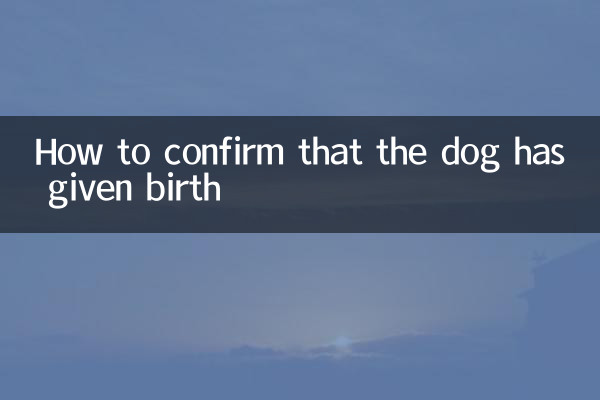How to confirm that the dog has given birth
For dog owners, the birth of a dog is a process that is both stressful and full of expectations. Knowing how to tell if a dog has given birth can help owners take better care of their mother and newborn puppies. Below is a detailed guide on how to determine when your dog is done, including structured data and key considerations.
1. Basic process of dog production

The birth process of dogs is usually divided into three stages: contraction period, delivery period and placenta expulsion period. Below is a detailed description of each stage:
| stage | duration | Main features |
|---|---|---|
| contraction period | 6-12 hours | The female dog appears restless, breathing rapidly, and may dig into the nest |
| labor period | 20-60 minutes between pups | The female dog gives birth forcefully, and the puppies are born one after another |
| placenta expulsion period | 1-2 hours after delivery | The placenta is being excreted one after another, and the female dog may eat the placenta. |
2. How to judge when the dog has given birth?
Here are a few key indicators to determine whether your dog is finished giving birth:
| Judgment index | Description |
|---|---|
| bitch behavior | The female dog stopped exerting force, acted calmly, and began to lick the pups. |
| Abdominal palpation | Abdomen is soft, no lumps, and may still be slightly contracted |
| Number of placentas | The number of placentas corresponds to the number of pups (usually one placenta per pup) |
| time interval | No contractions or signs of straining 2 hours after the birth of the last baby |
3. Precautions after production
1.Check the number of cubs: Confirm through palpation or ultrasound whether all pups have been born to avoid leaving stillbirths.
2.Observe the status of the female dog: If your bitch continues to be restless, has shortness of breath, or has excessive vaginal bleeding, seek medical attention immediately.
3.Clean and warm: Replace the puerperal pad in time to ensure that the puppies and bitch are in a warm and dry environment.
4.Nutritional supplements: Provide high-protein food and sufficient water for female dogs to help restore physical strength.
4. Frequently Asked Questions
| question | answer |
|---|---|
| What should I do if the production interval exceeds 2 hours? | It may be dystocia and you need to contact a veterinarian for examination. |
| What should I do if the placenta is not completely expelled? | Retained placenta can lead to infection and requires veterinary attention |
| What should I do if my mother dog doesn’t take care of her pups? | Artificial assisted feeding, or checking the female dog’s health problems |
5. Summary
Determining that a dog has given birth requires a combination of the female dog’s behavior, physical condition, and placental expulsion. If there are any signs of abnormality, such as continued contractions, weakness, or bleeding, it is important to seek medical attention immediately. After giving birth, the mother dog and puppies need to be provided with a quiet, hygienic environment and closely observed for at least 24 hours. Through scientific care, the health and safety of the mother dog and puppies can be ensured.

check the details

check the details